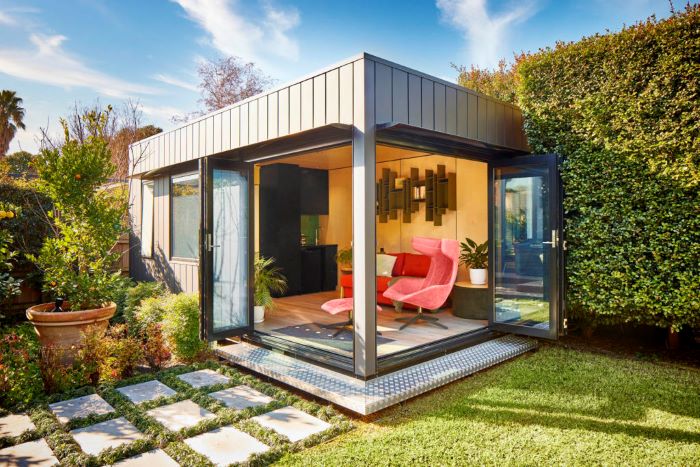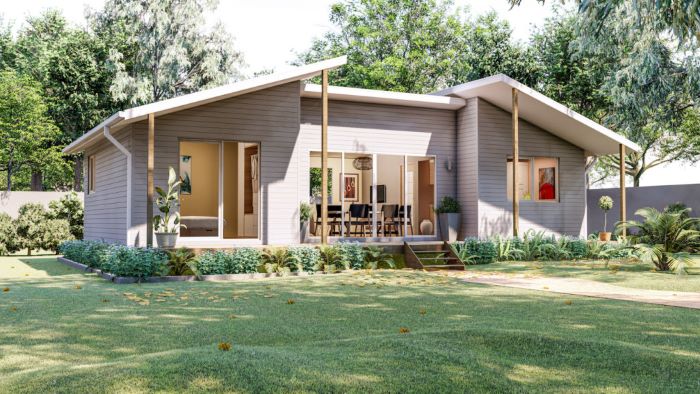With the cost of living increasing, the housing crisis escalating and working from home a seemingly permanent fixture in our lives, many people are starting to look at alternative building solutions such as tiny houses, granny flats and backyard “pods”. But what are the rules and regulations surrounding these structures?
Jason Fremder has been in the business of constructing and installing small backyard studio pods for a decade – long before working from home took off. His Melbourne company, Harwyn, takes care of all relevant forms and approvals for their clients.
Fremder explains that gaining council approval for this kind of structure in Victoria (the state that tends to have the most stringent requirements) is usually fairly quick and straightforward. Planning permits are only required in unusual situations, such as when there is a heritage overlay over the property or you’re wanting to put the pod in your front yard.

“If it’s in the backyard, out of sight, then planning very rarely comes into play,” Fremder says.
Building permits are sometimes needed, but he says that this, too, is usually a straightforward process.
“It’s a case-by-case basis. It depends on the land and so on, but some do, some don’t [require a building permit],” he says. “But again, it’s very simple.”
When it comes to granny flats, the situation can be a little more complicated – especially if you live in Victoria.
Granny flats built in the state often need to be classified as a Dependent Person’s Unit (DPU), meaning they’re subject to specific rules. Only one dependent person can live in the dwelling at a time, for example, and it has to be non-permanent so it can be removed as soon as the person stops living there. DPUs require a building permit in Victoria.
If it’s not classified as a DPU, then the structure is seen as a second dwelling (which may not be allowed in some areas, such as high-density or green wedge environments), and requires a planning permit as well as a building permit.
“Every job’s different,” says Peter Kiraly from iBuild, a company that specialises in building granny flats across the country. “It depends on what municipality you’re building in. Is it a built-up environment? Is it regional? If it’s regional, then it definitely becomes a lot easier.”
The Victorian government has recently trialled a pilot program in regional Victoria that might see the state more closely aligning with the granny flat regulations of other states, where the rules are more relaxed.

In NSW, where granny flats are much more common, they generally just require a Complying Development Certificate (or, occasionally a Development Application), plus an Occupation Certificate once construction is complete. Lots can’t be subdivided, but homeowners can rent out their granny flats to whomever they like.
Following the pandemic and recent natural disasters, the NSW government has changed the law so that people can live in moveable dwellings such as caravans, vans or “manufactured homes” on private property for up to two years without needing council approval.
In other states, however, living in a tiny house on wheels can prove a headache.
While approvals can be obtained for tiny houses attached to the land as permanent dwellings, moveable tiny houses – which constitute the overwhelming majority – occupy a strange grey area where they are usually lumped together with caravans.
“The 556 local governments in Australia all have different rules about how long you can live in a caravan,” explains John Cameron from the Australian Tiny Houses Association (ATHA). “In most places, it’s really restrictive … the vast majority of Australians are in a tiny home classified as a caravan and they’re at risk of being told to move on by local government.”
Like caravans, moveable tiny houses can be parked on private property – but, unless you’re in NSW, it’s technically illegal to reside in one for any decent period.
“I know of one lady up here in south-east Queensland who moves every three months or so,” Cameron says. “She just goes to the next place until she gets told to move on from there.
“One of our main goals is to get this cleared up so that people can live lawfully without being afraid of being forced to move on … without being forced to go down an expensive approval pathway every time they move.”
Tiny houses on wheels are also not subject to any building codes, but the ATHA team offers a guide on building these structures to code so they can be as robust as possible. Ultimately, Cameron and the rest of the organisation want to see the tiny house movement grow and gain greater legitimacy so people can live responsibly in tiny houses on private properties in the long term.
The bottom line is, if you’re thinking of investing in a granny flat, tiny house or backyard pod, find out what restrictions apply to your property and local council area.
Article source: www.domain.com.au
from Queensland Property Investor https://ift.tt/TlV8XB5
via IFTTT